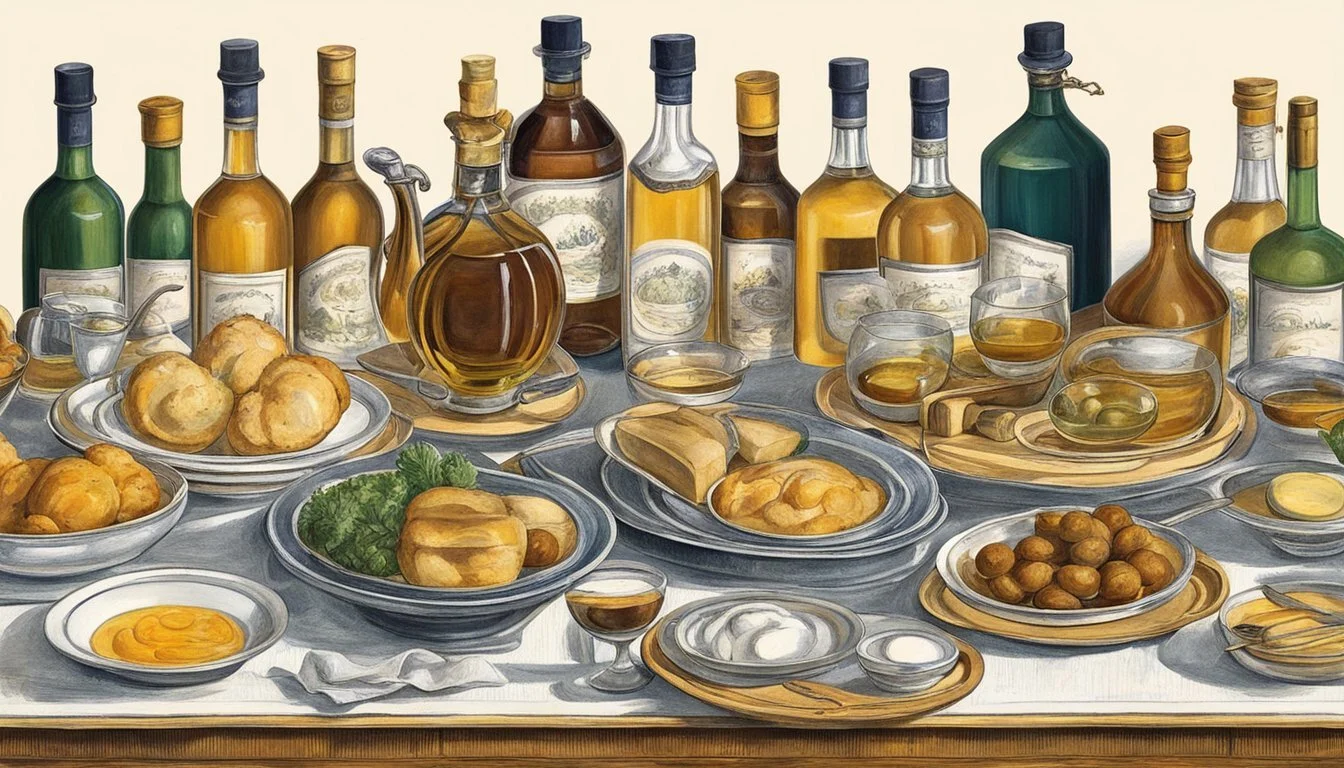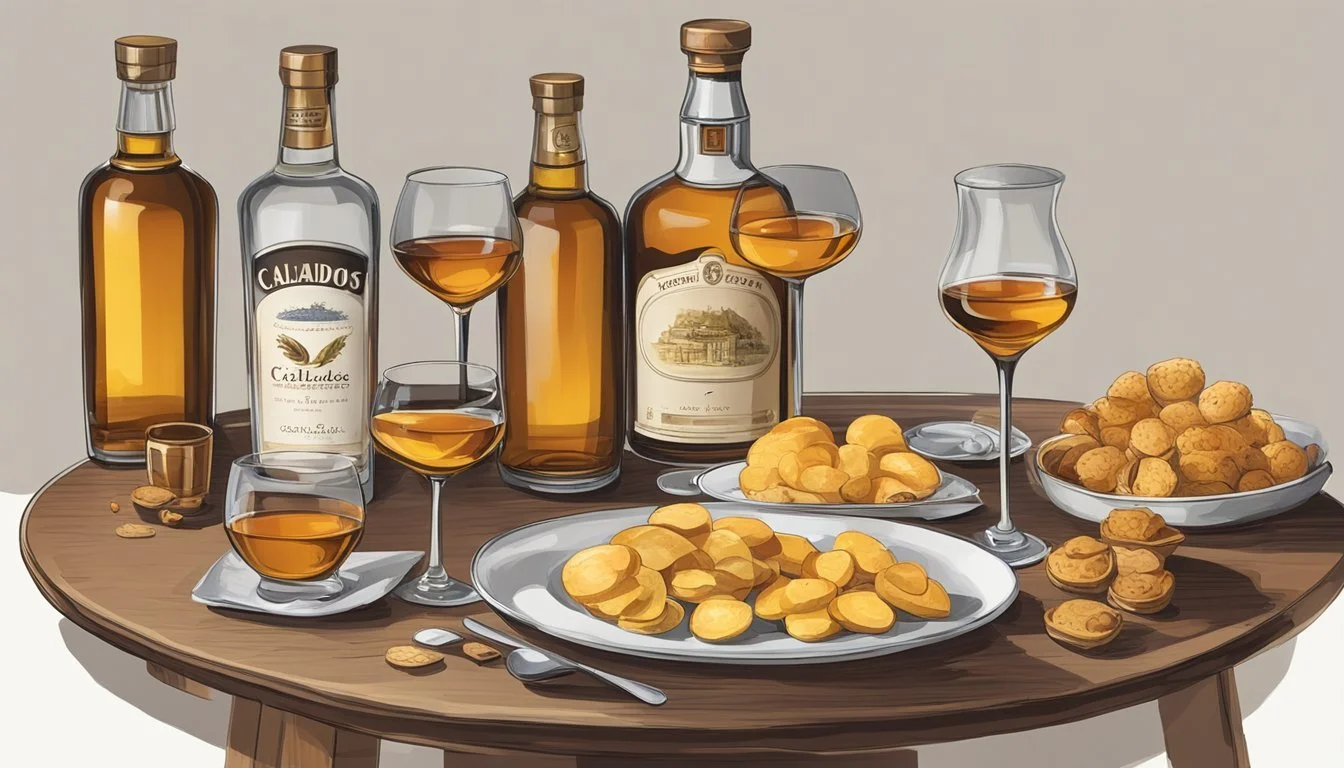How Many Servings of Calvados Is Too Much
Understanding Safe Consumption Limits
Enjoying Calvados, the renowned French apple brandy, can be a delightful experience, especially when sipped in moderation. It's essential to understand how to enjoy this beverage responsibly to fully appreciate its unique flavors without overindulgence.
Typically, a serving of Calvados is about 1.5 ounces (around 45 milliliters). For most adults, consuming more than two to three servings in an evening can begin to push the boundaries of moderation. Exceeding three servings of Calvados in a single sitting is generally considered too much and can lead to overconsumption of alcohol.
Remember, the key to enjoying Calvados lies in savoring its complex, aromatic qualities. Responsible drinking ensures not only a pleasant experience but also minimizes health risks.
Understanding Calvados
Calvados is a distinctive type of apple and pear brandy produced in the Normandy region of France. Its unique production process, diverse types, and rich history contribute to its complex flavors and appeal.
History of Calvados
Calvados traces its origins back to the production of cider in Normandy. The first recorded distillation of cider into brandy dates to the 16th century. By the 19th century, Calvados had gained a reputation distinct from other types of brandy.
The Phylloxera epidemic, which devastated European vineyards, indirectly bolstered Calvados as a popular alternative. The Norman tradition of distillation has been preserved and regulated, contributing to its present-day status.
Calvados Production Process
Calvados production begins with the selection of apples, sometimes pears, from orchards in Normandy. Over 200 varieties of apples are used, categorized into sweet, acidic, bitter, and bitter-sweet types.
Apples are pressed into cider, which ferments for several weeks. The cider is then distilled in either a single distillation (Pays d'Auge) or double distillation process. The resulting spirit is aged in oak barrels, imparting unique flavors over time.
Types of Calvados
There are various types of Calvados, categorized mainly by their aging process. Fine or Trois Étoiles are aged for a minimum of two years. Vieux (Reserve) are aged three years, while VO (Vieille Réserve) require at least four years.
VSOP and Hors d'âge are aged for at least five and six years, respectively. Each designation reflects a different aging process, resulting in distinct flavor profiles.
Appellations and Terroir
Calvados is governed by three main appellations: AOC Calvados, AOC Calvados Pays d'Auge, and AOC Calvados Domfrontais. Each appellation has specific regulations regarding the production methods and regions.
The terroir, including climate, soil composition, and rainfall, plays a significant role. For instance, Domfrontais allows up to 30% Perry pears in production, giving it a distinctive character.
Aging and Vintage
The aging process for Calvados is done in oak barrels. The interaction between the spirit and the wood allows the development of complex flavors such as vanilla, caramel, and spice.
Vintage Calvados is made from the fruit of a single year and is labeled with that year’s harvest. For non-vintage, blending different ages creates a consistent house style. Age statements on bottles indicate the youngest spirit used in the blend.
This clear and structured introduction provides a thorough comprehension of Calvados, shedding light on its extensive historical background, intricate production methods, varied types, specific appellations, and crucial aging processes.
Health and Nutrition
Understanding the health implications and nutritional aspects of consuming Calvados is essential for mindful consumption. This section covers the caloric content, overall nutritional profile, and key dietary considerations for this alcoholic beverage.
Caloric Content of Calvados
Calvados, a type of apple brandy, is calorie-dense. A standard 1.5-ounce serving can contain around 97 to 110 calories. This is primarily due to the alcohol content, which provides 7 calories per gram. Those monitoring their caloric intake should be aware that multiple servings significantly increase overall calorie intake, potentially impacting weight management.
Nutritional Profile
Calvados is low in essential nutrients like vitamins, fiber, and protein. It does not contribute significantly to daily nutritional requirements. The primary components are alcohol and water, with trace amounts of carbohydrates. Unlike whole apples, Calvados lacks dietary fiber and most of the phyto-nutrients found in fresh fruit.
Calvados is gluten-free, catering to individuals with gluten sensitivities or celiac disease. However, it is devoid of other beneficial compounds such as antioxidants, potassium, or substantial amounts of vitamins.
Dietary Considerations
Regular consumption of Calvados should be moderated due to its high caloric content and negligible nutritional benefits. For those following a balanced diet, overconsumption can lead to increased calorie intake without substantial nutritional gain. Alcohol itself, in excess, can interfere with the body’s absorption of nutrients and impact liver health.
When including Calvados in a diet, it is paramount to balance it with nutrient-dense foods to maintain a healthy nutritional balance. Eating a variety of fruits, vegetables, and whole grains can help offset the lack of nutrients in Calvados.
Safe Consumption
Calvados, an apple brandy from Normandy, France, can be enjoyed responsibly by adhering to recommended serving sizes and daily limits. Individual factors such as age, weight, and activity level also play a significant role in determining safe consumption levels.
Standard Serving Size
A standard serving size for Calvados is typically 1.5 ounces (about 44 milliliters). This measure is generally equivalent to a standard shot of liquor. Properly measuring servings helps ensure that consumption stays within safe limits. Using a jigger or measuring cup can be beneficial for those who prefer precision.
Recommended Servings Per Day
For adults, it is usually suggested to limit intake to one serving per day. This recommendation aligns with broader guidelines for alcohol consumption, aiming to prevent excessive intake. Consuming more than this daily limit can elevate health risks. It is generally advised that children and adolescents abstain from alcohol consumption entirely.
Individual Factors Influencing Intake
Several factors influence how much Calvados one can safely consume. Weight and age are primary considerations; heavier individuals and younger adults may metabolize alcohol differently. Activity level can also impact how alcohol affects the body. Consulting a dietitian can provide personalized advice, especially for those with specific health conditions or dietary restrictions.
Incorporating Calvados into Meals
Calvados, a versatile French apple brandy, can enhance a range of dishes whether served alongside or incorporated directly into recipes. Its unique flavors pair well with certain foods and can add depth to various culinary creations.
Pairing with Foods
Calvados pairs exceptionally well with desserts such as fruit tarts, tarte tatin, and chocolate-based cakes. These combinations highlight the pastry notes in the brandy, creating a harmonious experience for the palate.
For savory options, Calvados complements poultry, freshwater fish like trout, and seafood dishes. The apple and floral aromas play off these proteins, enhancing their flavors.
Additionally, Calvados serves as a delightful apéritif or digestif. Enjoy it before a meal to stimulate the appetite, or after to aid digestion while savoring its complex character.
Calvados in Cooking
Incorporating Calvados into cooking can elevate dishes with its distinctive apple and vanilla undertones. It can be used in sauces for poultry and meat, imparting a rich, layered flavor.
Calvados shines in desserts, particularly in caramel-based treats and fruit compotes. Its sweetness and acidity balance well with sugar and fruit.
When preparing dishes, consider the age of the Calvados. Younger varieties introduce fresh, lively notes, while aged versions contribute deeper, more concentrated flavors.
Use Calvados sparingly to avoid overpowering the dish. A small quantity can transform the complexity of a meal, providing a sophisticated and unique taste.
Comparing Calvados to Other Spirits
Calvados, a French apple brandy from Normandy, offers a distinct flavor profile. Compared to other spirits like Cognac, Rum, and Vodka, it holds unique qualities in taste, aging process, and usage.
Calvados vs Other Brandies
Calvados and Cognac both come from France, yet they differ significantly. Calvados is made from apples (and sometimes pears), while Cognac derives from grapes. This results in Calvados having a fruity, earthy character, contrasting with Cognac's rich, vinous notes.
The aging requirements also vary; Calvados typically ages for at least two years in French oak barrels, but high-quality varieties can age upwards of 20 years. Meanwhile, Cognac classifications such as VS, Réserve, and XO dictate aging periods. This aging impacts the complexity and smoothness of both brandies.
Cider Brandy, like Calvados, stems from fermented apple cider but is often less regulated than Calvados. Overall, these differences in ingredients and regulations define their unique tastes and usages.
Calvados and Other Alcohols
When compared to spirits like Vodka, Rum, and Absinthe, Calvados stands out due to its production and flavor. Vodka, known for its neutrality and versatility, is distilled from grains or potatoes, making it a blank canvas for cocktails, unlike the more flavorful Calvados.
Rum, distilled from sugarcane byproducts, delivers a sweet, molasses-like taste which contrasts with Calvados's fruity, apple notes. Rum can be aged or unaged, leading to different taste profiles such as dark and spiced varieties, while Calvados's primary characteristic is its apple essence.
Absinthe, with its strong anise flavors and high alcohol content, offers an entirely different tasting experience compared to the smooth, refined nature of aged Calvados. This diversity in aromas, tastes, and production methods highlights the unique place Calvados occupies in the world of spirits.
Responsible Drinking
When enjoying Calvados, it is crucial to understand alcohol limits and recognize its role in social settings. Drinking responsibly helps avoid adverse health effects and ensures a safe and enjoyable experience.
Understanding Alcohol Limits
Guidelines suggest that women should limit themselves to one serving of Calvados per day, while men can enjoy up to two servings. This moderation helps maintain health benefits and avoids issues related to binge drinking.
A serving of Calvados, often consumed neat as a digestif, generally contains a standard amount of alcohol. It is important to consider individual factors like activity level and nutritional balance while determining appropriate consumption levels for adults.
Understanding and respecting these limits can help maintain a balanced and healthy lifestyle. Overstepping these boundaries may lead to impaired judgment and adverse health effects.
The Role of Calvados in Social Settings
Calvados holds a specific place in social gatherings. Its exquisite flavor makes it a favorite in various settings. When served as a digestif, it complements desserts like fruit tarts and chocolate-based cakes.
Providing knowledge on responsible consumption, such as limiting servings per day, enhances social enjoyment and health benefits. Groups like the Guild often emphasize these practices to foster a social culture focused on moderation.
Awareness of surroundings and social customs can elevate the drinking experience. Responsible drinking behavior creates an environment where everyone feels comfortable and safe.
Appendix
In discussing the production and consumption of Calvados, it's essential to understand the terminology and historical tales that shape this iconic apple brandy. Below, we dive into specific terms and fascinating legends that provide a deeper appreciation of Calvados.
Glossary of Terms
Appellation: A designated area known for producing Calvados, ensuring the quality and origin of the spirit.
Charentais Copper Pot Still: Traditional still used in distilling Calvados, contributing to its unique characteristics.
Cider Apples: Specific varieties of apples grown in Orchards for making the cider base of Calvados.
Domfrontais: A region within the Calvados appellation, known for its Pear Trees alongside apple orchards, producing a distinct blend.
Ageing: The process by which Calvados matures in Oak Barrels, allowing it to develop rich flavors and Tannins over time.
Calvados Legends and Lore
Calvados is steeped in history and tradition, with many stories enhancing its charm. One legend speaks of Norman pirates who brought apple seeds to France, establishing the renowned apple orchards. Another tale involves monks distilling apple cider to create what we now recognize as Calvados.
The Legacy of Calvados production includes careful selection of cider apples and pears, a meticulous distillation process using Stills, and an Ageing process in oak barrels. This craft has been passed down through generations, maintaining the authenticity and quality of Calvados.
These stories and practices remind us that Calvados is more than just a drink; it's a testament to cultural heritage and artisanal skill.









